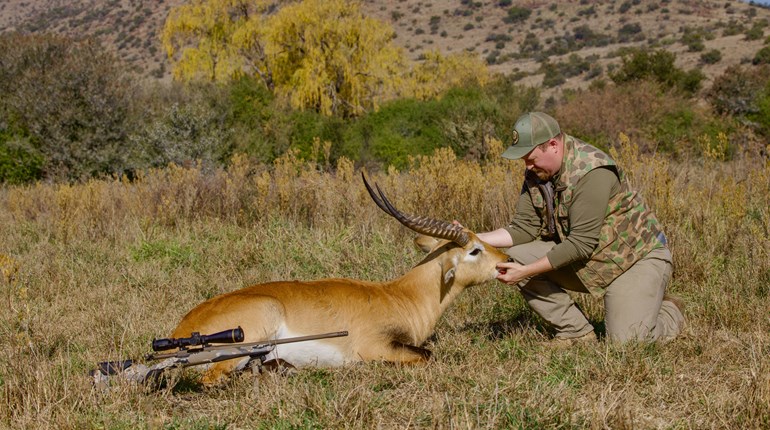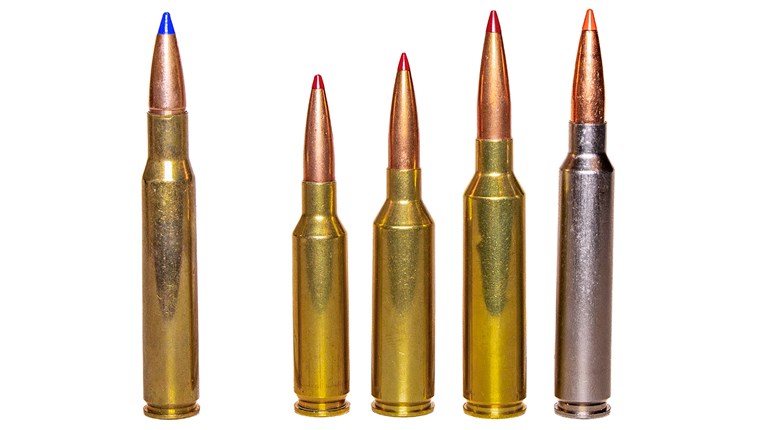
In December 1899, British forces pushed a group of Boers into a low mountain range southwest of Kimberley, South Africa. The fighting farmers, fearing the big guns of the British, placed lanterns in the hills and then trenched into the veld below. The ploy worked; after an intense bombardment of the mountains, the British forces—including the Royal Highlanders—advanced unsuspectingly into a disastrous ambush on the low ground. We’d located the buffalo I was after—a massive solitary bull—in those same hills. He too had moved into the brushy low lands. Our big guns readied, we advanced. Unlike the Black Watch, we were expecting to meet Black Death face to face.
And, we did.
■ ■ ■
The African Buffalo has become the preeminent dangerous game animal of the Dark Continent. Unlike the negativity often associated with hunting lion and elephant, buffalo hunting has yet to draw the same level of ire from the anti-hunting crowd. Including all five subspecies, it’s estimated there are as many as 1 million roaming the earth. We were after Syncerus caffer caffer, also known as the Cape or savannah buffalo. I’d hunted him before in the swamps of Mozambique. This quest was in South Africa, behind a fence encompassing thousands of acres.

My professional hunter was Geoffrey Wayland of Fort Richmond Safaris. Geoffrey is young in years but not in experience. Raised in the bush by a father who was a professional hunter, Geoffrey is as in tune with veld as Clapton is with his guitar. Last year he guided my then 17-year-old son to his first buffalo, unbelievably negotiating a lack of cover and swirling winds like the bushmen of old. As we stood glassing the vastness of the bush below, Geoffrey looked at me with his “this is going to be fun grin” and said, “We’re going to have to go down in there and find him.”
It didn’t take that long. Within 30 minutes we’d located the bull feeding with some impala, and we had enough cover to attempt a stalk. Single file, I followed Geoffrey and his .375; behind me was another PH with another .375, a tracker and my son with a video camera. At about 80 yards the bull unexpectedly burst from the bush. He locked up like a shorthair pointer, with that ominous nose raised in our direction, 80 yards out. Geoffrey placed the shooting sticks in front of me and raised his glasses.
I did not intend to shoot at that distance, but the front sight found the right spot and the .45-70 roared. The trigger press seemed more instinctive than premeditated. The bull bucked and whirled, but by that time I’d levered in another round and the XS Sights’ white-stripped front post had found the blackness again. We heard the thump of the second round, and then the bull disappeared into thickness of Africa.

It took a bit of looking, but we found blood and took up the spoor. A quarter-mile later our impression that my first shot had been good, vanished. So, we sent a tracker onto a kopje to take a look. Shortly, he signaled he’d found the bull, standing in the brush on a hillside another quarter-mile ahead. We pressed on with renewed confidence.
Unexpectedly—again—the bull burst from the cover he’d found and began running across our front at about 180 yards. I knew it was imperative to get another bullet in him—anywhere in him. I dropped to the sitting position, slung up and hit him. He bucked, stopped and I hit him again. That was all he wanted, and once more he disappeared into Africa. Grinning again, Geoffrey shouldered his rifle, looked at me and asked, “Are we having fun yet?”
Yes! We were.
■ ■ ■
Pressing on, we continued using elevation to help us locate the buff. After 15 minutes we stopped to sort out our dry mouths, and Geoffrey stepped onto a big rock to glass. He immediately motioned me over with haste, almost yelling in a whisper, “He’s there! At 30 yards with his ass to you! See him?”
I did indeed, but just as I shouldered the Marlin the bull bolted. I whacked him right in the bum with 430 grains. He lurched. I whacked him in the ass again. And, as he vacated his rocky, brush-choked hide, I put another .45-caliber bullet into his backside. The video would later confirm three shots in three seconds. Somewhat frustrated, I semi-yelled, “His ass was all I had to shoot at!” Calmly, Geoffrey said, “You did fine—three hits.” But now the danger was multiplied. Like the Boers of more than 100 years ago, the buffalo had established terms more suitable for him.
Slowly and cautiously, we followed the ample blood trail through head-high thorns and a tangle of washing machine-sized rocks. At times a dozen yards was as far as we could see in any direction. Ultimately, the spoor led us to the base of the hill and the cover opened. With our minds somewhat eased, we stopped to collect our thoughts and, as they say in Africa, “make a plan.”

We knew the bull was sick and hurting. We also knew he was ticked off and close. Geoffrey and the other PH talked strategy. I found a single Life Saver in my pocket—green apple—bit into it, and shared it with my son. It was the best piece of candy I’ve ever had. After a spell, we readied ourselves to move on. We’d only taken about 10 steps when the tracker shouted, “There he is!”
About 15 yards up the side of a low kopje, the bull stood condescendingly watching us. I could see the hate in his eyes and wasted no time. I immediately shouldered the rifle—this time with complete concentration and certainty—and shot him right in the shoulder. He went down and I shot him again, because, well, it just seemed like the right damn thing to do.
■ ■ ■
We made the final approach and Geoffrey let me “check” the bull. Granted, this is not common practice among professional hunters; they typically like to make sure the battle is over before clients lay hands on horn. But Geoffrey and I are more friends than hunter and client; over the last five years we’ve hunted with each other for months at a time. He was there, covering with his .375, but he let me end the hunt.
My first shot had raked the bull down his left side, with the bullet ending up in the paunch. The second was through the rear quarters but hit no bone or blood pipeline. Shots three and four, both fired at about 180 yards, entered and exited center body, one high, one low. Ultimately fatal, they failed to puncture heart or lung. Five, six and seven, fired as the buff was running away, found muscle and gut but no bone. One did penetrate deep enough to puncture a lung. The final shot was the shot I should have waited on to be the first; it was through the shoulder, lungs and the top of the heart.

This hunt got skirmish-like, but buffalo, as big as they are and as mean as they can be, are not hard to kill. A good bullet placed properly will do the job in a matter of seconds. I’m a decent rifle shot but my first shot was not well placed. I could come up with a variety of excuses, but the most accurate and honest explanation—the truth—is that I shot poorly.
When hunting things that can kill you, the adrenaline meter can peg-out. However, unlike with feral hogs, elk, warthogs and kudu, when tangling with dangerous game it’s vitally important—no, it’s seriously critical—to make your first shot nothing less than perfect. One properly placed shot is all that’s needed. Don’t be like the Black Watch or me. Never trust lanterns in the night, and make damn certain your first shot is one you’d bet your life on.
Enough Gun
The Marlin Custom Shop built the Modern Lever Hunter I used on this hunt. It comes standard with a large loop lever and an XS Sights Lever-Rail with an aperture sight. I could have opted for optics but a scope on a lever gun is like a saddle on a cat—some things just don’t make sense. I’d spent a week working with the rifle and XS Sights at Gunsite Academy, and had become very proficient; I could consistently place five out of five hits on a 12-inch plate at 200 yards.

However, in a 1987 American Rifleman article, former professional hunter Finn Aagaard wrote, “I like the ghost-ring aperture for its unobtrusiveness, its simplicity and its reliability under all weather conditions (except for the poorest light). But, everything considered, I believe the optimum sight for big-game hunting in the thick stuff, where ranges can vary from arm’s length to medium-long range, is the low-powered scope.”
I agree with Finn; an optical sight would have been nice for my first shot, but it was a shot I should have passed on anyway. I felt more comfortable with the XS Sights, especially after my hunt became a running gun battle. Nevertheless, Finn’s hypothesis was validated during our safari where five buffalo were taken with .45-70s. The only one-shot kill was delivered with a low-powered variable scope. Even so, I’m convinced when things get Western with a lever gun, there’s no better sight than those from XS. Your ability to wield a lever-action rifle with lithe quickness cannot be understated; it’s the principal attribute of the platform. For more information, visit marlinfirearms.com.





































